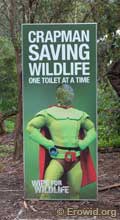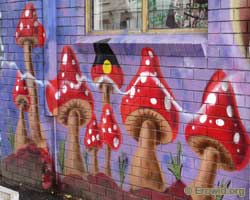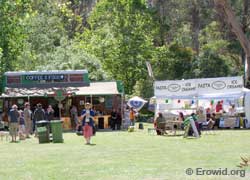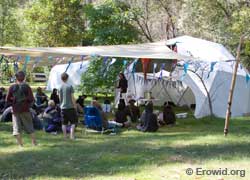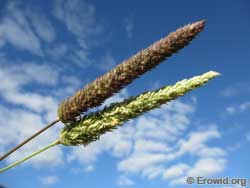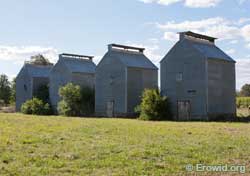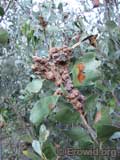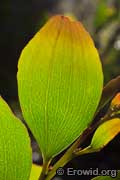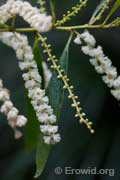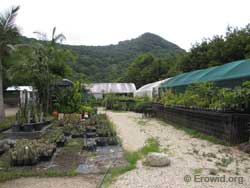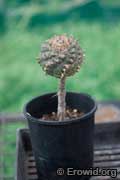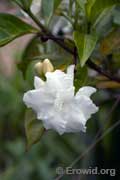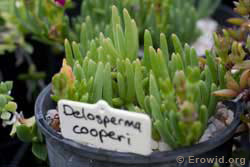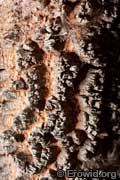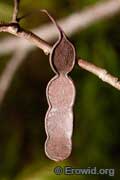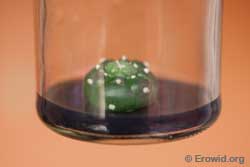Three Weeks of Plant Geekery
An Australia Travelogue
June 2012
Originally published in Erowid Extracts #22
Citation: Erowid F, Erowid E. "Three Weeks of Plant Geekery: An Australia Travelogue". Erowid Extracts. Jun 2012;22:12-19. Online edition: Erowid.org/conferences/conference_2011_ega.shtml
Fire and Earth were invited to be keynote speakers for the December 2011 Entheogenesis Australis (EGA) conference near Melbourne. They took the opportunity to travel, meet entheo-colleagues, and indulge their photo geekery.
The EGA organizers had arranged for someone to pick us up at the airport, provide us with a place to stay before the conference, and give us a ride to the venue. Scanning the baggage claim area, a gentleman in a purple, mushroom-embroidered jacket stood out as the most likely candidate. Bingo!
We introduced ourselves to our host, Michael Bock, and set off on the jet-lagged traveler's friend: a forced-march tour of local sights intended to keep us awake until the clocks on this side of the planet said it was time for sleep.
As we drove towards downtown Melbourne we also started our lessons in the local dialect. We found it surprisingly difficult to parse the Australian accent. Not only is pronunciation different, but so are inflection and cadence. A lot of uniquely Australian words add to the confusion: "mozzy" (mosquito), "sparky" (electrician), "ute" [yoot] (pickup truck), "chook" (chicken), "rellie" (relative), etc.
Our first stop was Fitzroy, a bohemian district northeast of the CBD (Central Business District, Australian for "downtown"), decorated with distinctive, whimsical and funky murals. We visited Polyester Books, a well-stocked counterculture bookstore with a great section on psychoactives. Next was Happy High Herbs, a widely known chain that sells herbs explicitly for their stimulant, relaxant, aphrodisiac, or psychedelic effects. We spent some time looking at their array of products, from smokables containing unspecified cannabinoid receptor agonists to party drugs labeled as containing octopamine, a stimulant related to epinephrine that occurs naturally in plants and invertebrates (and that can also be synthesized). The proprietors of both Happy High Herbs and Polyester Books said they would be sending representatives to EGA.
After strolling by bondage shops and organic grocery stores, we headed home for dinner where we met Michael's partner and their son and got a tour of his extensive library of literature about psychoactives and ethnobotany.
The jet lag treatment continued with a hike in Dandenong Ranges National Park. Friendly flocks of cockatiels and parrots happily landed and hopped along our shoulders, arms, and heads as we offered up seedy snacks.
One of the things we were looking forward to was the opportunity to see the psychoactive Acacia native to Australia. That first night, we became acquainted with the prevalence of both Acacia and Eucalyptus (called "Eucalypts" or "Gums") and how many different species and varieties there are of each. Our jaunt through the forest turned into a bit of a trek as we were caught by the approaching nightfall. At one point we turned our tiny LED flashlight on the first of many marsupials we would encounter during our trip, a brush-tailed possum staring at us from a small tree. As we blearily walked in the dark, foreign woods, surrounded by the noise of exotic birds, and following a psychedelically embroidered near-stranger, we felt far from home.
The next day we headed to Healesville Sanctuary, a wildlife conservation park, where we learned that, aside from the bipedal descendants of criminals, almost everything mammalian in Australia has a pouch. From inch-long mice to seven-foot-tall megafauna, the island continent is populated by marsupials. The Sanctuary is one of the best zoos we've ever visited: part public menagerie and part eco-research project. It also pressed home the point that, despite its odd familiarity, we were in a foreign land. From a large group of schoolchildren interacting with "Crapman" (a superhero promoting recycled toilet paper), to a koala carcass dissected and autopsied in front of families in a matter-of-fact fashion, cultural dissimilarities were confusingly interwoven with people and places nearly indistinguishable from their US counterparts.
The topography, flora, grounds, decorations, and people at EGA all felt surprisingly similar to those found at a comparable event in Northern California. From the beginning we were welcomed and treated like long-lost family members by pretty much everyone we met. People went out of their way to introduce us to others and we were awash in compliments about Erowid's usefulness. We made new friends and finally met old Internet allies whom we had known online for 10-15 years but had never been in the same physical space with. Despite being 8,000 miles from home, we were also pleased to run into a dozen familiar faces from around the world.
Big mown fields served as campgrounds for attendees while speakers were housed in two-person rooms and bunkrooms in large lodge buildings. One lawn was set up as the food area with six eateries serving out of quirky tents and a psychedelic bus.
A short walk away, one could stroll down a grassy path past vendor tents where visitors browsed herbs, labware, books, clothing, and art. Scattered nearby were a number of domes, one set up as a visually immersive chill space, a couple for smaller presentations and workshops, and a main dome where larger talks were held.
More than 50 speakers presented on topics ranging from political rants to drug recommendations to academic pharmacology lectures, with many talks focused on botany. An introduction to identifying the flora of the area, including Acacia species, was led by David Cameron, a senior botanist working for the state of Victoria. In one workshop, participants learned how to use thin layer chromatography to identify DMT and other tryptamines in plant material. Another demonstrated how to make smoking blends, like changa.
In perhaps the most amusing workshop, Torsten Wiedemann of Shaman Australis set up a complete distillation rig out of glassware that was offered for sale. He demonstrated distilling plant oils and then made potable absinthe for workshop attendees, all in a little over two hours. Keeper Trout, a friend from California, was the other keynote act. He delivered his cactus-related downloads with charisma and quirkiness, exemplifying his data-centric maxim: "More than you need to know?" The overall caliber and diversity of presentations were impressive.
Though there were more than 400 attendees, the conference drew a select crowd of knowledgeable and engaged participants. It was the kind of event where sitting down with virtually anyone would result in an interesting conversation about psychoactives, the subculture, chemistry, or plants.
The organizers made producing an event of this complexity look easy, with a few extra touches that highlighted their experience. One notable feature in the main dome was the inclusion of three screens on which presentations were displayed. Those in the back could read the slides!
Buffalo sallow wattle (Acacia phlebophylla) is a shrubby tree between 6 and 15 feet tall. It is renowned as a source of DMT and grows naturally only high up Australia's Mount Buffalo. We had read about the Buffalo wattle for years, and were thrilled when we discovered that we would be able to visit its habitat.
While in the car, we passed through an area near Myrtleford that was a major tobacco (Nicotiana tabacum) agricultural center until anti-smoking regulations crushed the market in 2006. Government incentives largely transitioned the fields to vineyards, but the area is still dotted with distinctive tobacco drying sheds. We stopped along the road to photograph some sheds and were greeted by a landowner, who explained that after ceasing tobacco production and replanting with grape vines, the price of grapes declined so sharply that the cost of harvesting was greater than the possible revenue from selling the crop. So she had let her cows loose in the vineyard to graze. She inquired as to whether we would like to buy her now-seriously-devalued property. We politely declined and said our goodbyes.
As we continued towards Mount Buffalo, Michael, an expert in Australian ethnobotany, pointed out that much of the grass growing along the highway was Phalaris aquatica, a DMT-containing grass that we'd never had a chance to photograph. We pulled over again to tromp through the highway margins, getting great photos of ripe seed heads.
A few miles later, Michael stopped the car and gestured toward a giant field overgrown with Phragmites australis, a DMT-containing reed. When Earth tried to pull one of the hardy leaves off to photograph it more closely, the sharp-edged blade of grass cut deeply into his hand, resulting in this trip's first Erowid blood spilled in the name of photo geekery.
At the edge of Mount Buffalo National Park, the terrain changes from open rolling hills to rocky, forested mountain. As our car climbed upwards, we eventually reached a sort of invisible line in elevation where A. phlebophylla starts growing. We pulled over and got our first look at the famed Buffalo wattle. A few individual shrubs grew along the roadside, with many more growing in the rocky soil a short distance up the slope.
Many of the shrubs at this spot had concerningly large galls on them from a fungal infection that has been damaging this unique species. The population has also been threatened by overharvesting. However, in recent years, DMT hunters have learned that the leaves of someAcaciaspecies, including A. phlebophylla, contain enough of the alkaloid that usable products can be made from leaves rather than root or stem bark, saving the bush from unneeded destruction.
Chasing the fading sunlight further up the mountain, we reached a spot where the road was lined on both sides with more Buffalo wattle. As a mnemonic aid for the hundreds of new flora we were seeing for the first time, Earth made a habit of nibbling tiny bits of various native plants throughout the trip. This brings out a plant's aroma and provides a quick sense of whether it is full of high-note terpenes, bitter alkaloids, drying tannins, or oily resins. When he took the smallest taste of the fresh A. phlebophylla seedpod he relearned that such exploration can have downsides. Just breaking the skin of the fresh pod with his teeth released a chemical that instantly burned his lips and tongue. Traces that reached his throat left a burned spot that lasted a day. As we gleefully took advantage of this singular opportunity to shoot way too many high-resolution photos, the sunset shifted from yellow to red, and we finally admitted it was time to stop photographing the Buffalo wattle.
Our return trip to Melbourne was more exciting than strictly necessary. First was the sighting of a small wallaby and then an echidna ("spiny anteater") that trundled across the road ahead of us in the dying light; we paused yet again for photos. Then a stop at an amazing city park in Benalla where a 3D "ceramic mural" flows organically up and down stairs, through tunnels, along benches, columns, and curves, surrounding a small amphitheater in surreal Gaudi-esque style. Handmade tiles, many created by the local community, turn the space into a work of art. Around 1 am, on our way back to Melbourne, we had three separate encounters with large eastern grey kangaroos that chose to jump into the road directly in front of our car. All hopped away from the experiences, but they, we, and the car were shaken and worse for the wear.
We spent two afternoons in Sydney walking the grounds of the Royal Botanic Gardens, finding the medicinal, psychoactive, and culinary plants that are always present in such spaces. We spotted Brugmansia, Myristica insipida (Australian nutmeg), Nicotiana tabacum (cultivated tobacco), Coffea arabica (coffee), Iochroma cyaneum (violet churcu), Dracaena draco (of dragon's blood incense fame), Brunfelsia pauciflora, Ephedra altissima, Artemisia absinthium, and many more.
In an amusing side trip, we took one evening to visit an absinthe bar. We had been to such bars before, one in Switzerland, another in San Francisco. We also have a friend who is a notorious absinthe artisan, so we're always up for a tasting. The rituals surrounding absinthe make drinking the beverage a memorable experience. But in this case, a quirky steward seemed determined to ruin our evening. After four of us selected the absinthes we would start with, small portions of the straight spirits were poured into our glasses. The ritual is to use an iced water fountain to drip water over a sugar cube into the glass, triggering the milky "louche" effect and diluting the spirit to a palatable concentration.
As we discussed the differing colors and smells of the four brands, we each attempted to sip the pure absinthe prior to adding water, to get a sense of the full flavor. We were immediately stopped short, our hands angrily smacked down by the aggressive waiter who told us we were not allowed to drink the absinthe straight. Despite explanations that we simply wanted to have a small taste, he insisted vehemently that it was not allowed, actually grabbing our glasses to stop us. He treated us as though we had made reservations to pay $15 per glass and be literally locked in to this richly decorated retro salon in order to slam a few shots of high-proof, anisey alcohol with the intent of getting as drunk as possible. It was uncomfortable and off-putting, thus we recommend avoiding the authoritarian snobs at the Absinthe Salon in Sydney.
After getting off the freeway, with its police cameras and robotic traffic ticketing systems, we took the highway west into rolling hills. Towns architecturally reminiscent of Iowa in countryside more like California each had at least two pubs, a lawn bowling club, and a Chinese restaurant (often in the bowling club).
At the Sphinx Rock we also met new friends. We were introduced to Ray and Liz Thorpe of Happy High Herbs. After lunch, a quick tour of their home demonstrated how creative and energetic the Thorpes are, from their mushroom-domed master bedroom, to visionary hand-made decor, custom cat mazes, zoo-like animal collection, and botanic gardens. When the local gang heard we were coming to town, the Thorpes generously offered to let us stay at their Old Convent Guesthouse in Uki [yoo-kai]. The guesthouse is part of an airy, high-ceilinged, Colonial-style convent from the 1920s. The beautiful building overlooking a small river became our home base for the next week.
On our first day there we discovered how lucky we were with sighting native Australian animals. We caught a few glimpses of a platypus swimming in the river, something we're told most residents never see because these duck-billed, egg-laying, venomous oddities of the mammal world are so uncommon. And while that was the rarest animal we encountered, we were also lucky to see a koala and its joey chilling in a tree next to a convenience store.
The defining animal experience in Uki, however, was watching the staggeringly large colony of flying foxes living in the trees in town. The distinctive smell of bat urine hung heavily in the air near the bridge and each night at dusk, the sky filled for more than 30 minutes with thousands of impressively noisy bats with three-foot wingspans, heading off to find fruit.
Happy High Herbs coordinates more than 40 shops around the world from their office and small warehouse in Uki. We had the opportunity to meet their crew, who mix activism, enthusiasm, and commercialism in their bid to make psychoactive plant products more widely available. While some people at EGA were critical of HHH for overhyping herbal preparations and selling party drug replacements with questionable contents, everyone agreed that Ray Thorpe and HHH have been key boundary-pushing elements in the psychedelic politics of Australia for more than a decade. We found their staff friendly, knowledgeable, dedicated, and clear about the effects of their products.
As we drove around, we kept catching glimpses of large white mushrooms growing in fields along the road. While we were too far away and moving too quickly to make positive identification, they looked like Psilocybe cubensis. It turns out we had arrived just in time for the annual psilocybin explosion. One afternoon, we got permission to traipse around a field peppered with hundreds of untouched P. cubensis growing on and around the cow pies. Locals told us that despite being potent, they were so plentiful that the contraband fungi have essentially no commercial value and most go unpicked.
The five of us started off meandering around the amazing private gardens of a quiet entheo-botanist. As he led the way, pointing out the psychoactive flora he'd cultivated, Fire lagged behind, trying to get usable photos of each and every plant. Our guides exhibited extraordinary patience, waiting while we took pictures, especially as this wasn't even supposed to be part of our day-long botany field trip.
The stores in town range from upscale organic, to hippie chic, to adorably confused stoner stylings. One of the required stops was the Hemp Embassy, a non-profit pro-cannabis political hub and hemp products store. Another was the locally legendary Hemp Museum, a maze of a building packed with counterculture imagery and marijuana memorabilia: a 1960s VW microbus, drug-related newspaper stories glued to the walls, hand-painted artwork, kitschy rabble-rousing insights, and trippy murals.
When police installed cameras on the street outside the museum, cannabis dealing moved into its twisty interior until repeated police raids pushed dealers towards more covert methods. We were only offered cannabis a couple of times while walking through town, about the same as a stroll along Upper Haight in San Francisco.
After a stop at a picturesque 100-meter waterfall, Mulga brought us to a site with large stands of flowering Acacia obtusifolia, a species that thrives on forest edges, in damp, sunny spots, and along cliffs. The leaves of A. obtusifolia, as with Buffalo wattle, contain DMT in high enough concentrations that they can be used in the preparation of changa. Mulga demonstrated that one can take a twig, ignite it, put out the flame, and detect the distinctive indole smell of DMT in the smoke. Wandering through the hills of northern New South Wales, as with the southern countryside near Melbourne, we were struck by the number of viable DMT sources. DMT is everywhere... at least in Australia.
Despite the horde of land leeches, this was one of the most amazing days of our trip, with the perfect combination of intellectual conversation, photography, and mad-dash forest botanizing.
The property is located on the lower slopes of a largely undeveloped mountainside in northern New South Wales, a few miles northwest of Byron Bay. The Gardens host a commercial operation, consisting of thousands of potted and in-ground plants, from tiny seedlings to full grown trees. A dozen eclectic structures, including greenhouses, shade buildings, shipping containers, humidity tents, and seedling nurseries, cover several acres.
The site is a stunning, world-class working ethnobotanical collection specializing in psychoactive and medicinal plants. Through expert trial and error, they have learned to grow everything from the culinary Capsicum (pepper) species, gourmet spicy Greek oregano, and Hierochloe odorata (bison grass, a source of the vanilla-like coumarin), to Brunfelsia americana, Heimia salicifolia, Passiflora incarnata, Tabernanthe iboga, Voacanga africana, Lophophora williamsii, Banisteriopsis caapi, Psychotria viridis, Arundo donax, Phalaris arundinacea, and full-grown Anadenanthera colubrina trees. From flowering specimens, to seeds, down to petri dishes for experimental germination practices, we spent more than six hours over two days giddily racing behind Torsten as he showed us just the fraction of plants he thought we'd be most interested in photographing.
After dinner one night, as the sun was setting, Torsten led us on a speed-walk tour of the psychoactive plants growing on the beach at Brunswick Heads near Byron Bay. We had a flash with us so we got some good identification shots, but when it started to drizzle, the less photo-obsessed of our team lost patience with our single-minded attempt to digitize every plant with ethnobotanical significance. We got shots of Canavalia maritima, Ipomoea pes-caprae, and Acacia sophorae, before the weather and darkness forced us back to socializing. What became clear, as Torsten rattled off a continuous stream of details about each plant, was that he is both an entheo-geek provocateur as well as one of the world's top experts in psychoactive plants.
The spirit of exploration and psychoactive inquiry is incredibly strong in Australia, powered by some of the most intelligent, inquisitive, and well-educated drug geeks in the world. Forced by circumstance to "grow local", they are digging in and making use of the plant and chemical allies in their environment and building the knowledge base for the next generation.
It was an amazing treat to get to spend most of our time with knowledgeable botany dorks. We were in heaven. During our three-week trip, we took nearly 6,000 photos, filling 63 GB of drive space. This treasure trove of photos will serve us well over the next year as we illustrate articles and add to Erowid's vaults. Thanks to everyone who went out of their way to welcome us and introduce us to the botany and local psychedelic culture.

|
Arrival and Acclimation
As we'd been warned, the flight to Australia was long and tiring. Despite resetting our internal sleep clocks prior to embarking, we were dazed when we arrived in Melbourne at midday. After the obligatory nervous pass through customs (Who wants to explain a box full of papers and books about psychoactive drugs to a customs official?), we looked around for our contact.The EGA organizers had arranged for someone to pick us up at the airport, provide us with a place to stay before the conference, and give us a ride to the venue. Scanning the baggage claim area, a gentleman in a purple, mushroom-embroidered jacket stood out as the most likely candidate. Bingo!
|
We introduced ourselves to our host, Michael Bock, and set off on the jet-lagged traveler's friend: a forced-march tour of local sights intended to keep us awake until the clocks on this side of the planet said it was time for sleep.
As we drove towards downtown Melbourne we also started our lessons in the local dialect. We found it surprisingly difficult to parse the Australian accent. Not only is pronunciation different, but so are inflection and cadence. A lot of uniquely Australian words add to the confusion: "mozzy" (mosquito), "sparky" (electrician), "ute" [yoot] (pickup truck), "chook" (chicken), "rellie" (relative), etc.
Our first stop was Fitzroy, a bohemian district northeast of the CBD (Central Business District, Australian for "downtown"), decorated with distinctive, whimsical and funky murals. We visited Polyester Books, a well-stocked counterculture bookstore with a great section on psychoactives. Next was Happy High Herbs, a widely known chain that sells herbs explicitly for their stimulant, relaxant, aphrodisiac, or psychedelic effects. We spent some time looking at their array of products, from smokables containing unspecified cannabinoid receptor agonists to party drugs labeled as containing octopamine, a stimulant related to epinephrine that occurs naturally in plants and invertebrates (and that can also be synthesized). The proprietors of both Happy High Herbs and Polyester Books said they would be sending representatives to EGA.
After strolling by bondage shops and organic grocery stores, we headed home for dinner where we met Michael's partner and their son and got a tour of his extensive library of literature about psychoactives and ethnobotany.
As we blearily walked in the dark, foreign woods, surrounded by the noise of exotic birds, and following a psychedelically embroidered near-stranger, we felt far from home.
One of the things we were looking forward to was the opportunity to see the psychoactive Acacia native to Australia. That first night, we became acquainted with the prevalence of both Acacia and Eucalyptus (called "Eucalypts" or "Gums") and how many different species and varieties there are of each. Our jaunt through the forest turned into a bit of a trek as we were caught by the approaching nightfall. At one point we turned our tiny LED flashlight on the first of many marsupials we would encounter during our trip, a brush-tailed possum staring at us from a small tree. As we blearily walked in the dark, foreign woods, surrounded by the noise of exotic birds, and following a psychedelically embroidered near-stranger, we felt far from home.
The next day we headed to Healesville Sanctuary, a wildlife conservation park, where we learned that, aside from the bipedal descendants of criminals, almost everything mammalian in Australia has a pouch. From inch-long mice to seven-foot-tall megafauna, the island continent is populated by marsupials. The Sanctuary is one of the best zoos we've ever visited: part public menagerie and part eco-research project. It also pressed home the point that, despite its odd familiarity, we were in a foreign land. From a large group of schoolchildren interacting with "Crapman" (a superhero promoting recycled toilet paper), to a koala carcass dissected and autopsied in front of families in a matter-of-fact fashion, cultural dissimilarities were confusingly interwoven with people and places nearly indistinguishable from their US counterparts.
| Changa in Australia |
| With hundreds of native species of , the discovery that several contain DMT in their bark and leaves (as opposed to only in root bark) has recently made smokable DMT a signature part of the Australian subculture. "Changa" (pronounced chāng-uh) is a term coined in Australia for the combination of DMT and an MAOI, deposited on an herbal smoking blend. These blends include a variety of herbs, and may contain 5-MeO-DMT or plants with other mild psychoactive properties. During our trip, we saw changa joints passed around and were offered changa, to try or buy, numerous times. Compared to pure DMT, the slightly less abrupt onset and comedown curve of changa, combined with its milder smoke, apparently changes to whom and under what circumstances the fractal-crystalline visuals and psychedelic cognitive effects are interesting. One person told us that changa use is prevalent even among young people who are not otherwise inclined towards psychedelics but who smoke it while watching movies or playing video games. They describe that, "It makes the movies pop!" Another person mentioned that use has increased among the equivalent of American "trailer park" culture in Australia. "While changa may lack the razor sharpness of pure DMT, it nicely enhances the experience in a profound way that permits one to really go deep. Not so much by making the DMT stronger, but rather by producing richer and more robust effects." -- Justin Case, Austin, Texas
|
Entheogenesis Australis
The EGA conference was held on a beautiful piece of property in the Strathbogie Ranges, about two hours northeast of Melbourne. Michael drove us there via a scenic route through the mountains where we stopped in a small park to lunch under enormous trees, with brilliant crimson rosella parrots joining us at the picnic table.The topography, flora, grounds, decorations, and people at EGA all felt surprisingly similar to those found at a comparable event in Northern California. From the beginning we were welcomed and treated like long-lost family members by pretty much everyone we met. People went out of their way to introduce us to others and we were awash in compliments about Erowid's usefulness. We made new friends and finally met old Internet allies whom we had known online for 10-15 years but had never been in the same physical space with. Despite being 8,000 miles from home, we were also pleased to run into a dozen familiar faces from around the world.
Big mown fields served as campgrounds for attendees while speakers were housed in two-person rooms and bunkrooms in large lodge buildings. One lawn was set up as the food area with six eateries serving out of quirky tents and a psychedelic bus.
A short walk away, one could stroll down a grassy path past vendor tents where visitors browsed herbs, labware, books, clothing, and art. Scattered nearby were a number of domes, one set up as a visually immersive chill space, a couple for smaller presentations and workshops, and a main dome where larger talks were held.
More than 50 speakers presented on topics ranging from political rants to drug recommendations to academic pharmacology lectures, with many talks focused on botany. An introduction to identifying the flora of the area, including Acacia species, was led by David Cameron, a senior botanist working for the state of Victoria. In one workshop, participants learned how to use thin layer chromatography to identify DMT and other tryptamines in plant material. Another demonstrated how to make smoking blends, like changa.
In perhaps the most amusing workshop, Torsten Wiedemann of Shaman Australis set up a complete distillation rig out of glassware that was offered for sale. He demonstrated distilling plant oils and then made potable absinthe for workshop attendees, all in a little over two hours. Keeper Trout, a friend from California, was the other keynote act. He delivered his cactus-related downloads with charisma and quirkiness, exemplifying his data-centric maxim: "More than you need to know?" The overall caliber and diversity of presentations were impressive.
Though there were more than 400 attendees, the conference drew a select crowd of knowledgeable and engaged participants. It was the kind of event where sitting down with virtually anyone would result in an interesting conversation about psychoactives, the subculture, chemistry, or plants.
The organizers made producing an event of this complexity look easy, with a few extra touches that highlighted their experience. One notable feature in the main dome was the inclusion of three screens on which presentations were displayed. Those in the back could read the slides!
|
Mount Buffalo Excursion
After a group buffet lunch on the last day, we packed our bags, hopped in the car with Michael, and headed further northeast to Mount Buffalo.Buffalo sallow wattle (Acacia phlebophylla) is a shrubby tree between 6 and 15 feet tall. It is renowned as a source of DMT and grows naturally only high up Australia's Mount Buffalo. We had read about the Buffalo wattle for years, and were thrilled when we discovered that we would be able to visit its habitat.
While in the car, we passed through an area near Myrtleford that was a major tobacco (Nicotiana tabacum) agricultural center until anti-smoking regulations crushed the market in 2006. Government incentives largely transitioned the fields to vineyards, but the area is still dotted with distinctive tobacco drying sheds. We stopped along the road to photograph some sheds and were greeted by a landowner, who explained that after ceasing tobacco production and replanting with grape vines, the price of grapes declined so sharply that the cost of harvesting was greater than the possible revenue from selling the crop. So she had let her cows loose in the vineyard to graze. She inquired as to whether we would like to buy her now-seriously-devalued property. We politely declined and said our goodbyes.
As we continued towards Mount Buffalo, Michael, an expert in Australian ethnobotany, pointed out that much of the grass growing along the highway was Phalaris aquatica, a DMT-containing grass that we'd never had a chance to photograph. We pulled over again to tromp through the highway margins, getting great photos of ripe seed heads.
A few miles later, Michael stopped the car and gestured toward a giant field overgrown with Phragmites australis, a DMT-containing reed. When Earth tried to pull one of the hardy leaves off to photograph it more closely, the sharp-edged blade of grass cut deeply into his hand, resulting in this trip's first Erowid blood spilled in the name of photo geekery.
At the edge of Mount Buffalo National Park, the terrain changes from open rolling hills to rocky, forested mountain. As our car climbed upwards, we eventually reached a sort of invisible line in elevation where A. phlebophylla starts growing. We pulled over and got our first look at the famed Buffalo wattle. A few individual shrubs grew along the roadside, with many more growing in the rocky soil a short distance up the slope.
Many of the shrubs at this spot had concerningly large galls on them from a fungal infection that has been damaging this unique species. The population has also been threatened by overharvesting. However, in recent years, DMT hunters have learned that the leaves of someAcaciaspecies, including A. phlebophylla, contain enough of the alkaloid that usable products can be made from leaves rather than root or stem bark, saving the bush from unneeded destruction.
Chasing the fading sunlight further up the mountain, we reached a spot where the road was lined on both sides with more Buffalo wattle. As a mnemonic aid for the hundreds of new flora we were seeing for the first time, Earth made a habit of nibbling tiny bits of various native plants throughout the trip. This brings out a plant's aroma and provides a quick sense of whether it is full of high-note terpenes, bitter alkaloids, drying tannins, or oily resins. When he took the smallest taste of the fresh A. phlebophylla seedpod he relearned that such exploration can have downsides. Just breaking the skin of the fresh pod with his teeth released a chemical that instantly burned his lips and tongue. Traces that reached his throat left a burned spot that lasted a day. As we gleefully took advantage of this singular opportunity to shoot way too many high-resolution photos, the sunset shifted from yellow to red, and we finally admitted it was time to stop photographing the Buffalo wattle.
Our return trip to Melbourne was more exciting than strictly necessary. First was the sighting of a small wallaby and then an echidna ("spiny anteater") that trundled across the road ahead of us in the dying light; we paused yet again for photos. Then a stop at an amazing city park in Benalla where a 3D "ceramic mural" flows organically up and down stairs, through tunnels, along benches, columns, and curves, surrounding a small amphitheater in surreal Gaudi-esque style. Handmade tiles, many created by the local community, turn the space into a work of art. Around 1 am, on our way back to Melbourne, we had three separate encounters with large eastern grey kangaroos that chose to jump into the road directly in front of our car. All hopped away from the experiences, but they, we, and the car were shaken and worse for the wear.
Sydney
After one more photo orgy at a botanical garden near Melbourne, we flew north to Sydney where we met up with futurist, and longtime friend, Mark Pesce. Though it's too expensive to casually visit from the US, Sydney turned out to be one of our new favorite cities: an English-speaking, hip, and modern metropolis standing as a western gateway to Southeast Asia.We spent two afternoons in Sydney walking the grounds of the Royal Botanic Gardens, finding the medicinal, psychoactive, and culinary plants that are always present in such spaces. We spotted Brugmansia, Myristica insipida (Australian nutmeg), Nicotiana tabacum (cultivated tobacco), Coffea arabica (coffee), Iochroma cyaneum (violet churcu), Dracaena draco (of dragon's blood incense fame), Brunfelsia pauciflora, Ephedra altissima, Artemisia absinthium, and many more.

|
As we discussed the differing colors and smells of the four brands, we each attempted to sip the pure absinthe prior to adding water, to get a sense of the full flavor. We were immediately stopped short, our hands angrily smacked down by the aggressive waiter who told us we were not allowed to drink the absinthe straight. Despite explanations that we simply wanted to have a small taste, he insisted vehemently that it was not allowed, actually grabbing our glasses to stop us. He treated us as though we had made reservations to pay $15 per glass and be literally locked in to this richly decorated retro salon in order to slam a few shots of high-proof, anisey alcohol with the intent of getting as drunk as possible. It was uncomfortable and off-putting, thus we recommend avoiding the authoritarian snobs at the Absinthe Salon in Sydney.
Heading North
After a few days in the city, we set off with Pesce, driving north on the next leg of our tour. We'd traveled with him several times before, and once again he was a fantastic traveling companion. Earth and I love car trips because they provide long periods for conversations to build, meander, and come back around, and Mark is a fantastic conversationalist; well read, opinionated, playfully pushy, and yet a great listener. He recommended the longer, but more interesting inland route and we jumped at the chance to spend a couple of days on the road with him.After getting off the freeway, with its police cameras and robotic traffic ticketing systems, we took the highway west into rolling hills. Towns architecturally reminiscent of Iowa in countryside more like California each had at least two pubs, a lawn bowling club, and a Chinese restaurant (often in the bowling club).
We received invitations to visit homes, labs, gardens, fields, and parks where we photographed hundreds of psychoactive plants.
Happy High Uki
When we reached the Northern Rivers area of New South Wales, about ten hours north of Sydney, we stopped at the Sphinx Rock Café and joined up with Darklight, a friend we first met at Mind States Jamaica. We were fortunate to have her as our guide in the area. She made it possible to cram our week full of botanical- and psychoactive-related fun and made sure we'd never forget our visit.At the Sphinx Rock we also met new friends. We were introduced to Ray and Liz Thorpe of Happy High Herbs. After lunch, a quick tour of their home demonstrated how creative and energetic the Thorpes are, from their mushroom-domed master bedroom, to visionary hand-made decor, custom cat mazes, zoo-like animal collection, and botanic gardens. When the local gang heard we were coming to town, the Thorpes generously offered to let us stay at their Old Convent Guesthouse in Uki [yoo-kai]. The guesthouse is part of an airy, high-ceilinged, Colonial-style convent from the 1920s. The beautiful building overlooking a small river became our home base for the next week.
On our first day there we discovered how lucky we were with sighting native Australian animals. We caught a few glimpses of a platypus swimming in the river, something we're told most residents never see because these duck-billed, egg-laying, venomous oddities of the mammal world are so uncommon. And while that was the rarest animal we encountered, we were also lucky to see a koala and its joey chilling in a tree next to a convenience store.
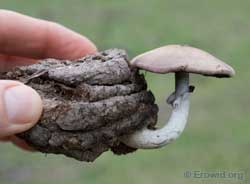
|
Happy High Herbs coordinates more than 40 shops around the world from their office and small warehouse in Uki. We had the opportunity to meet their crew, who mix activism, enthusiasm, and commercialism in their bid to make psychoactive plant products more widely available. While some people at EGA were critical of HHH for overhyping herbal preparations and selling party drug replacements with questionable contents, everyone agreed that Ray Thorpe and HHH have been key boundary-pushing elements in the psychedelic politics of Australia for more than a decade. We found their staff friendly, knowledgeable, dedicated, and clear about the effects of their products.
Photo Geeks Gone Wild
In the Northern Rivers area around Uki, our photography took a serious turn for the absurd. We received invitations to visit homes, labs, gardens, fields, and parks where we photographed hundreds of different psychoactive plants.As we drove around, we kept catching glimpses of large white mushrooms growing in fields along the road. While we were too far away and moving too quickly to make positive identification, they looked like Psilocybe cubensis. It turns out we had arrived just in time for the annual psilocybin explosion. One afternoon, we got permission to traipse around a field peppered with hundreds of untouched P. cubensis growing on and around the cow pies. Locals told us that despite being potent, they were so plentiful that the contraband fungi have essentially no commercial value and most go unpicked.
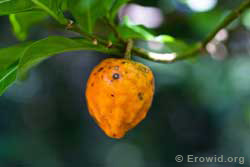
|
Botany Tour
We spent one day botanizing around Nimbin, the hippie-subculture capital of eastern Australia, accompanied by the team of Mulga, Erik, and Des, three well-informed and good-humored Aussies. The surrounding temperate and sub-tropical rainforests are near enough to the ocean to have a constantly high level of moisture and humidity. The area is lushly overgrown jungle, interspersed with pastures, and ringed by timeworn mountains.The five of us started off meandering around the amazing private gardens of a quiet entheo-botanist. As he led the way, pointing out the psychoactive flora he'd cultivated, Fire lagged behind, trying to get usable photos of each and every plant. Our guides exhibited extraordinary patience, waiting while we took pictures, especially as this wasn't even supposed to be part of our day-long botany field trip.
Land Leeches!
Perhaps the main thing that kept us moving was the plague of land leeches (Gnatbobdellida libbata). We were familiar with blood-sucking leeches that live in rivers, ponds, and lakes, but we'd never encountered fast-moving, ground leeches, which sport suckers on both ends! It was a bumper year for these pests and we constantly had to dance around and yank them off our shoes, socks, and legs. When we stood still, dozens would approach rapidly from all directions, like an army of assault worms. They not only attack from the ground, but also drop from trees, and can pass quickly through loosely woven clothing or socks, latching on in seconds. Learning the technique for grabbing a leech (roll it into a ball so it doesn't have time to grab on, then fling it away) was perhaps the most creepily memorable experience of our hikes in the area. They are the bloody bane of botanists in the Northern Rivers because they inject an anticlotting agent as they bite, which keeps the wound bleeding. Apparently folks who grow up with them find them a mild nuisance instead of a shudder-inducing nightmare.
|
Nimbin Town
We stopped in Nimbin for a bite to eat and to pick up thick bamboo socks to make the leeches climb further up our legs before they could feed. Nimbin is a key counterculture center in Australia. Following the Aquarius Festival, a hippie gathering that brought thousands of non-conformist folks to this farming town in 1973, Nimbin became a focal point for alternative communities, psychedelics, and cannabis culture.The stores in town range from upscale organic, to hippie chic, to adorably confused stoner stylings. One of the required stops was the Hemp Embassy, a non-profit pro-cannabis political hub and hemp products store. Another was the locally legendary Hemp Museum, a maze of a building packed with counterculture imagery and marijuana memorabilia: a 1960s VW microbus, drug-related newspaper stories glued to the walls, hand-painted artwork, kitschy rabble-rousing insights, and trippy murals.
When police installed cameras on the street outside the museum, cannabis dealing moved into its twisty interior until repeated police raids pushed dealers towards more covert methods. We were only offered cannabis a couple of times while walking through town, about the same as a stroll along Upper Haight in San Francisco.
Nightcap
After Nimbin, we were led through the rainforested slopes of Nightcap National Park. The heavy summer rains had left each leaf and rock glistening or dripping. Moss and fungi covered everything. We began on a peak and spent a couple of hours walking the muddy paths downhill. Our botanists regaled us with tales of the flora, from the enormous blackbutt (Eucalyptus pilularis) and nightcap wattle (Acacia orites) to impressively old grass trees (Xanthorrhoea spp.).After a stop at a picturesque 100-meter waterfall, Mulga brought us to a site with large stands of flowering Acacia obtusifolia, a species that thrives on forest edges, in damp, sunny spots, and along cliffs. The leaves of A. obtusifolia, as with Buffalo wattle, contain DMT in high enough concentrations that they can be used in the preparation of changa. Mulga demonstrated that one can take a twig, ignite it, put out the flame, and detect the distinctive indole smell of DMT in the smoke. Wandering through the hills of northern New South Wales, as with the southern countryside near Melbourne, we were struck by the number of viable DMT sources. DMT is everywhere... at least in Australia.
Despite the horde of land leeches, this was one of the most amazing days of our trip, with the perfect combination of intellectual conversation, photography, and mad-dash forest botanizing.
Lab Botany
During our trip we had the opportunity to visit Darklight's plant tissue-culture facility, where she researches the propagation and conservation of entheogenic, medicinal, and endangered plant species. We spent an afternoon hanging out with feral Australian botanists and researchers, discussing in vitro growing methods, drinking wine, and photographing tiny sprouts and cells in jars.Shaman Australis Nursery
We've known Torsten online for over a decade, but hadn't met the founder of Shaman Australis (SA) before this trip. We arrived late one afternoon for a tour of Wandjina Gardens (where SA grows its seeds, herbs, and live plants) and we were immediately enraptured by the density and variety of the collection.The property is located on the lower slopes of a largely undeveloped mountainside in northern New South Wales, a few miles northwest of Byron Bay. The Gardens host a commercial operation, consisting of thousands of potted and in-ground plants, from tiny seedlings to full grown trees. A dozen eclectic structures, including greenhouses, shade buildings, shipping containers, humidity tents, and seedling nurseries, cover several acres.
The site is a stunning, world-class working ethnobotanical collection specializing in psychoactive and medicinal plants. Through expert trial and error, they have learned to grow everything from the culinary Capsicum (pepper) species, gourmet spicy Greek oregano, and Hierochloe odorata (bison grass, a source of the vanilla-like coumarin), to Brunfelsia americana, Heimia salicifolia, Passiflora incarnata, Tabernanthe iboga, Voacanga africana, Lophophora williamsii, Banisteriopsis caapi, Psychotria viridis, Arundo donax, Phalaris arundinacea, and full-grown Anadenanthera colubrina trees. From flowering specimens, to seeds, down to petri dishes for experimental germination practices, we spent more than six hours over two days giddily racing behind Torsten as he showed us just the fraction of plants he thought we'd be most interested in photographing.
Byron Bay Area
Torsten and his partner Daniel not only run Wandjina Gardens, but are also part owners in a new retail business called Koda Phytorium, which has a storefront in Byron Bay selling herbs, teas, extracts, cosmetics, books, and other plant-medicine related items. Koda has some overlap in products with Happy High Herbs, but has none of the rainbow-hippie subcultural flavor and instead has a pharmacy aesthetic. Koda sells pure isolates and chemicals where allowed by law, but their edgiest offerings are labware and glassware: everything from beakers to distillation apparatus. The Koda team scrupulously follows the law, requiring glassware purchasers to supply identification, but this shop is pushing boundaries and doing it with a sober, scientific flair.DMT is everywhere... at least in Australia.
Through the Looking Glass
Our visit to eastern Australia was a strange mix of familiar and alien. The terrain and culture near Melbourne were so much like Northern California that, as long as no one was speaking, it felt like home. Unlike California, Australia stood out as an island nation in this ultra-connected world, with restrictive border controls and interstate quarantines (putatively designed to protect the indigenous flora and fauna) that exemplify an underlying authoritarian governmental philosophy that is on the rise around the world.The spirit of exploration and psychoactive inquiry is incredibly strong in Australia, powered by some of the most intelligent, inquisitive, and well-educated drug geeks in the world. Forced by circumstance to "grow local", they are digging in and making use of the plant and chemical allies in their environment and building the knowledge base for the next generation.
It was an amazing treat to get to spend most of our time with knowledgeable botany dorks. We were in heaven. During our three-week trip, we took nearly 6,000 photos, filling 63 GB of drive space. This treasure trove of photos will serve us well over the next year as we illustrate articles and add to Erowid's vaults. Thanks to everyone who went out of their way to welcome us and introduce us to the botany and local psychedelic culture.



